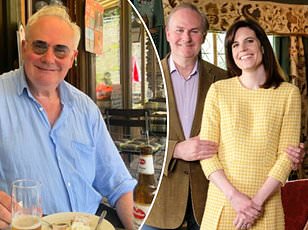EXCLUSIVEThis botanist helped catch Ian Huntley, Levi Bellfield, the Suffolk strangler and hundreds more. Now 'Pollen Pat' explains how she cracked Holly and Jessica's murders - and why plants are just as incriminating as fingerprints
Standing waist-deep in a grassy ditch, surrounded by stinging nettles, with rain hammering down and lightning flashes overhead, Patricia Wiltshire found herself toe-to-toe with the lifeless, burned bodies of two ten-year-old girls.
The scene was strangely peaceful, she recalls, like a 'green cathedral', a marked contrast to the flurry of frenzied police and media activity happening all around.
The girls were 'lying side by side as though in bed together', she says. Had their bodies not been so brutally disfigured, they might have been asleep.
Thirteen days previously, on August 4, 2002, Holly Wells and Jessica Chapman, schoolgirls from the Cambridgeshire town of Soham, had disappeared during a family barbecue. Ian Huntley, a school caretaker, was later convicted of their abduction and murder.
On discovering the bodies of his victims, near RAF Lakenheath, an American air base in neighbouring Suffolk, police immediately called Patricia to take a look.

Leading forensic ecologist Patricia Wiltshire, 82, has worked on more than 300 cases — sometimes up to 40 a year — with every police force across the UK and Ireland
Wading into a ditch with two dead bodies might seem an incongruous place for a petite, grey-haired woman in her sixties who has, in latter years, found herself compared to Miss Marple.
But Patricia wasn't fazed; she'd done this sort of work before, countless times. As the world's leading forensic ecologist, the Welsh-born scientist has worked on more than 300 cases — sometimes up to 40 a year — with every police force across the UK and Ireland.
Her extensive career in botany and palynology (the study of plant pollen and spores) has proved crucial in solving horrific murders, abductions, rapes and everything in between — making her the secret weapon of detectives across the globe. (A valuable role which was publicly acknowledged earlier this month when she was chosen to appear on Radio Four's Desert Island Discs.)
Rather than combing crime scenes for DNA or fingerprints, Patricia turns her attention to the microscopic, using techniques she's honed over 30 years to detect evidence in the natural world.
In the Soham murders, Patricia was able to link Huntley to the grisly discovery in the ditch through botanical traces on his shoes, car and two petrol cans used to set the girls' bodies alight.
She was also able to tell detectives how long the girls had been there (by analysing the growth of 'side shoots' on surrounding plants), and describe how Huntley had lifted them in, by spotting trampled nettles to reveal a path down the steep bank.
'I found Jessica's hair on a twig,' she says. 'It was a long, golden-brown strand.' The image is not one she will ever forget. But Patricia is not one to dwell on the horrors or depravity with which she is confronted in her day job.

In July 2000, Sussex Police asked for Patricia's help in finding Sarah Payne, an eight-year-old who'd gone missing from a cornfield near her grandparents' home

Patricia also helped police probing the murder of 13-year-old Milly Dowler, who disappeared on her walk home from school in Walton-on-Thames, Surrey, in March 2002

On August 4, 2002, Holly Wells and Jessica Chapman, schoolgirls from the Cambridgeshire town of Soham, had disappeared during a family barbecue
Now 82, she has, quite literally, seen it all. Her work has helped convict some of Britain's most notorious killers, including Roy Whiting, Levi Bellfield and Steve Wright, the Suffolk Strangler. Astonishingly, she's still taking on new cases.
'Crime is all about sex, money or drugs,' she says. 'Very little surprises me these days. At the scene, it's just a job. I prefer not to know about the victims, because you will be thinking 'how awful'.
'But you can't let every case get you, otherwise you would be a nervous wreck.'
Quite how a Welsh coal miner's daughter, who grew up in a working-class family in Cefn Fforest, a small village north of Cardiff, came into this line of work is not a conventional story.
Patricia didn't have a happy childhood. Born to 'volatile' parents who divorced when she was 16, she was a sickly infant, suffering from measles, whooping cough, pneumonia, bronchitis and pleurisy.
Then, aged seven, a prank gone wrong resulted in her mother spilling boiling chip fat over her head, and she spent two years in agony, her scalp wrapped in bandages. She later had to have a lung removed because of a chronic cough.
Often off school because of her poor health, Patricia took refuge in a set of children's encyclopedias, learning about world religions, flags and mythology, and teaching herself hobbies such as knitting and music. She also grew close to her maternal grandmother, Vera, a keen horticulturalist, who ignited in her a passion for nature which was to shape the rest of her life.
'Her garden was magical,' Patricia remembers. 'She loved plants. I used to spend hours looking at things, playing and investigating. She'd show me where to find birds' nests and snapdragons; she taught me you could eat young hawthorn leaves and wild garlic.
'I was always thrilled by it. I can't imagine anyone being completely indifferent to plants.'

Rather than combing crime scenes for DNA or fingerprints, Patricia turns her attention to the microscopic, using techniques she's honed over 30 years to detect evidence in the natural world

Patricia's extensive career in botany and palynology (the study of plant pollen and spores) has proved crucial in solving horrific murders, abductions and rapes
But botany as a career came later; she left school halfway through her A-levels and moved to London to work as a medical lab technician, then spent a decade doing office work after a boyfriend told her it was a more 'ladylike' profession.
She finally completed her A-levels at evening classes and then, aged 28 and recently married to her first husband, was persuaded to enroll in a botany degree at King's College London, where her lecturers included Francis Darwin, the great-grandson of Charles. 'I really found my niche,' she says. 'It was wonderful. There were so many 'ologies' to discover and I wanted to learn them all.'
After graduating, she stayed at King's for another 15 years, lecturing in microbial ecology and soil science, before moving to University College London.
There, she worked as a palynologist at the Institute of Archaeology, studying pollen traces at ancient sites such as Pompeii and Hadrian's Wall.
It wasn't until 1994 when, sitting in her home study in Ashtead, Surrey, with her head bent over her Leica microscope — the same one she would later use to catch Huntley — Patricia got a phone call that would change everything.
'There was a strong Glaswegian accent at the end of the line, asking, 'Are you Pat Wiltshire?' she recalls. 'He said, 'We've been to Kew Gardens and they can't help us, but they said you could'. So I said, 'OK, what do you need me to do?' He said, 'We've got a murder and we want you to take a look at it'.'
Shocked but intrigued — dead bodies were, after all, quite different to archaeological digs — Patricia agreed to examine a car that had been requisitioned by Hertfordshire Police. They'd found tyre tracks in a field adjacent to a man's burning body, which they believed had been dumped by a Chinese Triad gang, but needed more evidence to proceed.
'I said to the police, 'Look, I don't know what I'm doing'. They wanted me to try anyway.'
Patricia took the car to pieces, scrubbed it using medical shampoo, and, amazingly, was able to find microscopic traces of pollen-laden soil that matched the field in its footwells and pedals.
'I was really quite pleased with that,' she admits. 'There was a sort of satisfaction that I'd solved a puzzle. 'Rather than combing crime scenes for DNA or fingerprints, Patricia turns her attention to the microscopic, using techniques she's honed over 30 years to detect evidence in the natural world

Patricia has helped catch some of Britain's most notorious killers, including Levi Bellfield who was convicted for the murder of Milly Dowler

School caretaker Ian Huntley was convicted of the abduction and murder of Holly Wells and Jessica Chapman

Convicted sex offender Roy Whiting was found guilty of the murder of eight-year-old Sarah Payne
And the puzzles kept on coming. Shortly afterwards, the same police force called her back for help in a rape case. Once again, her work proved invaluable — and word started to spread.
As her caseload grew, Patricia — who earned the nickname 'Pollen Pat' — started developing her speciality, learning more with each new crime.
'I had no teacher; I made it up as I went along, developing the science myself,' she explains. 'I suppose I was a pioneer.'
When she arrived at a crime scene, Patricia would ask for complete silence to immerse herself in the location, often closing her eyes — much to the bemusement of onlookers — as she tried to imagine what had happened.
No-nonsense and unafraid to speak her mind, she earned a reputation for being prickly, once admitting: 'I think I prefer some bacteria to some people.'
But what truly made her stand out from others in the field — and there have only been one or two — was her uncannily strong stomach.
At ease handling dead bodies, one of her signature techniques involves taking samples from a corpse's turbinate bones, located above the nostrils. This requires her to remove the top of the skull and go through the brain cavity, using a crochet hook.
Do such gory procedures ever make her squeamish? She gives a wry smile. 'No, I don't have time for that. If you can't do the job, then get out and do something else.'
Women, she adds, tend to be more suited to forensic work, especially the gruesome kind, than men. 'They're used to changing dirty nappies without a fuss,' she points out.
In July 2000, Sussex Police asked for Patricia's help in finding Sarah Payne, an eight-year-old who'd gone missing from a cornfield near her grandparents' home.
Tragically, the little girl's body was found 16 days later less than 12 miles away in a field near Pulborough — and Patricia's investigations, matching pollen, spores and soil on clothing and a spade belonging to convicted sex offender Roy Whiting to vegetation at the site, proved crucial in his conviction.

A police officer lays flowers near the place where the bodies of Holly Wells and Jessica Chapman were found near Lakenheath, Suffolk, in 2002
Two years later, she helped police probing the murder of 13-year-old Milly Dowler, who disappeared on her walk home from school in Walton-on-Thames, Surrey, in March 2002.
When her body was found in woodland six months later, Patricia analysed leaves, plants and tree litter to establish a timeline for her murder (for which serial killer, rapist and sex offender Levi Bellfield was convicted in 2011).
She was integral, too, in catching the killers of Karen Doubleday and Joanne Nelson, both strangled by their boyfriends, in 2002 and 2005, and tracking down Steve Wright, the so-called Suffolk Strangler, who murdered five sex workers in 2006.
'That was a hard case for me,' she admits. 'I'd get home, then the phone would be ringing again. I'd be rushing off to East Anglia because another body had been found. I worked on every corpse.'
She was also tasked with helping in the search for Suzy Lamplugh, the estate agent who went missing in London in 1986 — but to no avail, with Suzy still missing almost four decades later.
It is not the high-profile cases that affect her most, however.
Though she tries to maintain a professional detachment, Patricia admits that some stories she's encountered have felt 'like being kicked in the stomach'.
'There are several that won't give me peace, and I will think about those victims for ever,' she says. 'One was a 22-year-old prostitute who had three children by unknown men, and had been chucked out of her home by uncaring parents when virtually a child herself. I cried for her.
'Another was an exquisitely beautiful Scandinavian teenage girl who looked like Sleeping Beauty in the mortuary, and whose life had been snuffed out by a thug in some woods.
'Then there was a baby who hadn't even suckled but had multiple stab wounds and was dumped in a plastic bag in a hedge.'
The last one holds deep personal resonance. For Patricia, too, lost a baby — her daughter Siân, who died from an autoimmune disease when she was just 19 months old.
'She was the precious jewel in my life,' she says. 'It's the worst thing that has ever happened to me. But it protects you, because nothing else is as horrible.'
For years — indeed, until she met her second husband, Professor David Hawkstone, 77, a leading fungi expert — Patricia was so scarred by her loss than she couldn't say Siân's name.
'I never mentioned her. She was inside me; she was mine,' she says, her soft Welsh accent faltering for the first time. 'Nobody knew. A lot of my friends and colleagues were shocked when they found out about Siân. Being with David has allowed me to speak about her for the first time.'
Patricia (who left her first husband aged 62, after four decades of marriage) met David at a mutual friend's memorial service in 2006, and they married three years later. He is, she admits, 'the great joy of my life'. She dedicates her second book, The Natural History Of Crime, which came out in March, to Siân and David; her first was in memory of her grandmother.
Patricia had no more children, instead finding solace in the love of animals: several cats and their 14-year-old rescue dog, Ruby, who is curled by her feet, tail wagging contentedly, as we speak.
She and David now combine forces on tricky cases, with David's specialist fungi knowledge filling gaps in her own expertise — making them the ultimate forensic dream team.
Now in her ninth decade, Patricia isn't scared about what comes next. 'You, I, we'll all be recycled,' she explains. 'I think it's incredibly comforting. My molecules will be used and reincarnated as a tree or a bluebell or a beetle.'
As for work, she fears forensic ecology is a dying art — 'It's all IT this and DNA that' — so is determined to keep her craft alive, for as long as she is able.
'I've got one job left: it's a big murder in New Zealand,' she reveals. 'I'm 83 next birthday and all my friends are slowing down. I've started to notice that I'm a bit less steady on my feet. I used to have so much energy.
'But if a job came along, especially if it was complicated — I love complicated jobs — I'd struggle to turn it down.
'If something sparks my interest, well, we'll see...'




























































































































































































































































































































































